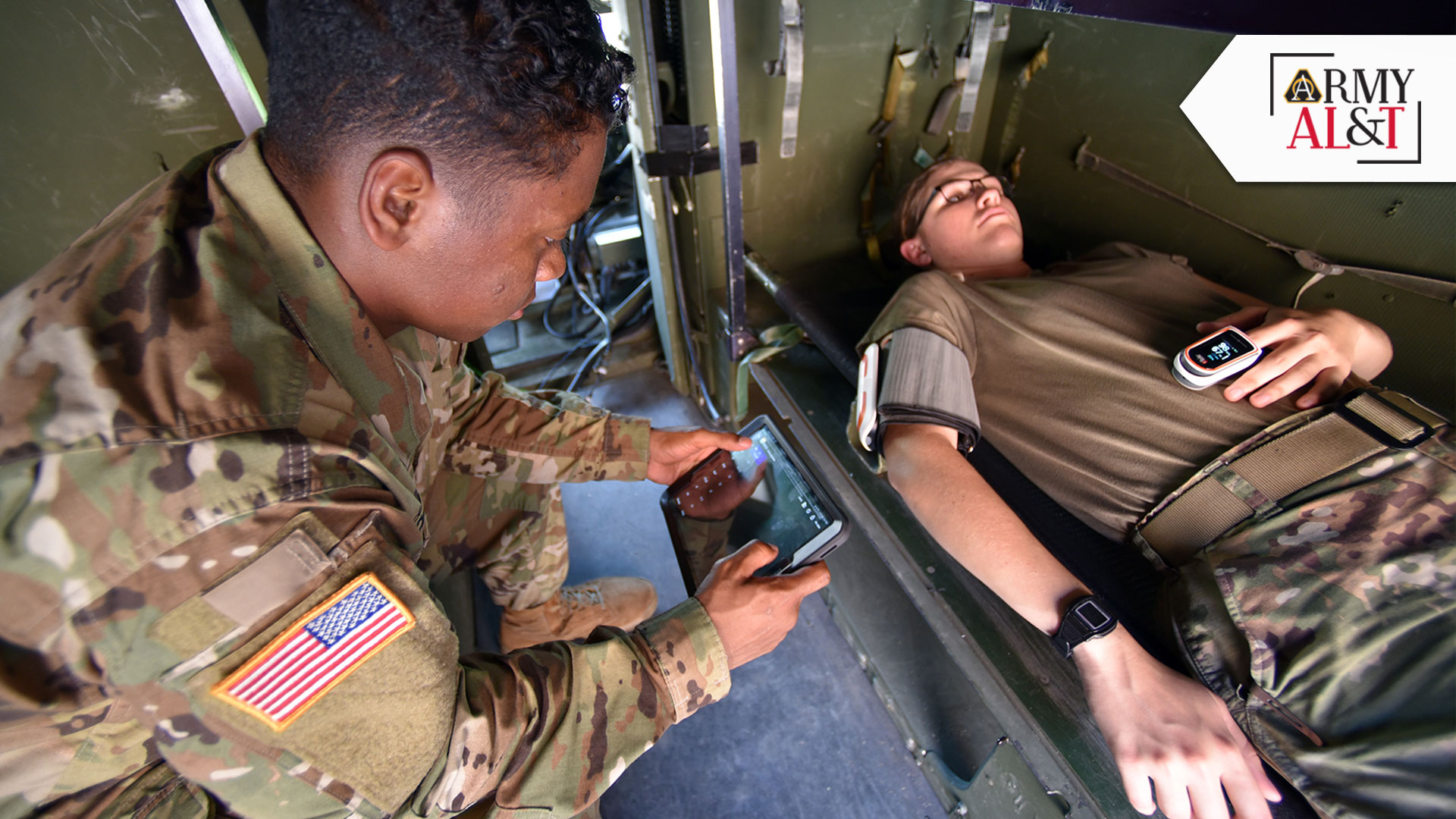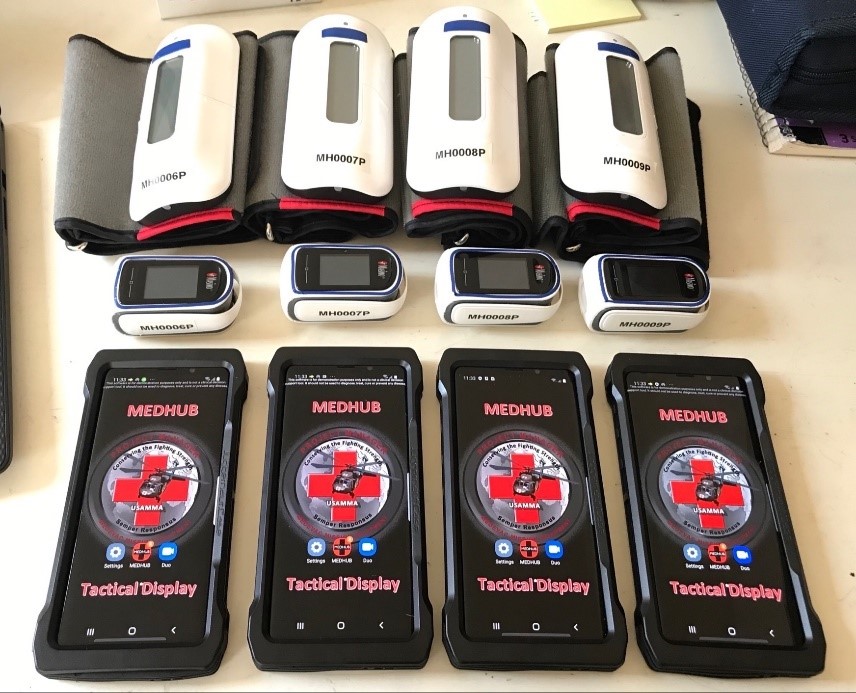
MADE EASY TO USE: Spc. Nathaniel Coleman, a treatment non-commissioned officer with the 44th Medical Battalion, demonstrates MEDHUB system in a field hospital setting. The MEDHUB system was refined for a more user-friendly interface in the fall of 2020. (Photo courtesy of U.S. Army)
Medical devices, MEDHUB enable hospital to send COVID-19 patients home sooner.
by Ashley N. Force
When a patient is hospitalized with COVID-19, they are not the only ones whose health is in jeopardy. Other patients and health care providers also are at risk of the disease. To help combat this , the Carl R. Darnall Army Medical Center at Fort Hood, Texas, established a virtual ward powered by the Transport Telemedicine Systems’ Medical Hands-free Unified Broadcast, better known as MEDHUB. The new ward officially kicked off in August and enables stable patients, including those with COVID-19, to be discharged home with additional monitoring capabilities.
“In the beginning of the pandemic, the projected numbers indicated we would soon be overwhelmed as far as bed space and staff to take care of patients,” said Army Lt. Col. Amanda Love, executive officer of Darnall Army Medical Center. “We were trying to think of ways to provide the most care possible. One of the ideas was this virtual ward concept.”
The virtual ward is fittingly named because it extends hospital space remotely. It’s similar to a ward in a physical hospital, only instead of being staffed with a direct-care person, the virtual ward is staffed to manage many patients from a distance. The virtual ward is not a physical space but an added capability to remotely monitor patients while they are being cared for by family and friends. The virtual ward received four MEDHUB systems to test this concept. There are nurse case managers and a physician “virtualist” to monitor patients.
DEFINE ‘VIRTUAL’
Patients who qualify for the virtual ward are deemed to be clinically at low risk; they do not meet the threshold of needing extra care in the hospital but should still be monitored. The hospital sends these patients home with medical devices that allow hospital staff to watch them from Darnall, while allowing their family members to help care for them.
The patient-monitoring capabilities are made possible by the MEDHUB system of the U.S. Army Medical Materiel Development Activity (USAMMDA). A new variation of this system was rapidly produced to meet the mission needs of the virtual ward. The MEDHUB concept was established in 2017 to serve as a medical communication platform that exchanges trauma patient information between U.S. Army medics and the hospitals receiving them during medical evacuations.
Typically, messages would be delivered from an ambulance to a field hospital using DOD satellite radio networks. Engineers within USAMMDA’s Warfighter Health, Performance and Evacuation Project Management Office, as well as a software team at the Software, Simulation, Systems Engineering and Integration (S3I) Directorate within the U.S. Army Combat Capabilities Development Command Aviation & Missile Center, tailored MEDHUB’s software to support home monitoring at the virtual ward.
“I am so proud of all the people who worked on producing a variation of MEDHUB within 60 days. In my opinion, that is an amazing feat,” said Jay Wang, the product manager in the Warfighter Health, Performance and Evacuation Project Management Office. “It is exciting and validating to have our system and software platform in real-world applications and operations.”
MEDHUB’s modified software allows for patients who do not require ventilation to recover at home and have their medical information virtually transmitted to the Darnall Medical Center. Patient information is exchanged using cellular networks in place of the DOD satellite radio networks, for which the MEDHUB system was originally programmed. This modification required the software team at S3I to develop a custom virtual ward website for the clinicians at Darnall.

KITTED UP: The MEDHUB system kits each contain a cellphone with the MEDHUB software, a pulse oximeter and blood pressure monitor. Each patient assigned to the Carl R. Darnall Army Medical Center Virtual Ward receives one. (Photo by Jennifer Lee)
ADAPTING THE DEVICE
To support the virtual ward, MEDHUB underwent a software change to track patient medical information. The original version of MEDHUB tracks each occurrence when a patient is transported in an ambulance. Their medical data is displayed at the hospital for the duration of the medical evacuation, which lasts anywhere from 15 to 30 minutes. With the virtual ward software, patient information is tracked over the course of several days in a patient’s home, versus the short ambulance ride.
Heart rate, blood pressure, oxygenation and temperature are some of the data that MEDHUB monitors in patients at home. These signals are especially important to track among COVID-19 patients. Higher heart rate and temperature indicate that a person may have active disease state and be likely to transmit the virus. Oxygen saturation is also a big indicator that someone might be displaying effects of COVID-19. It is a respiratory disease; therefore, as a patient’s oxygen saturation goes down, they will have more difficulty breathing.
THERE’S AN APP FOR THAT
MEDHUB’s easy-to-use system works as an app on a smartphone. Data collected by medical devices, such as pulse oximeter and blood-pressure cuff, is sent via Bluetooth to smartphone connected to the patient’s home WiFi. That, in turn, transmits the data so that hospital staff can access it. The app also allows the patient to view their readings from the wireless vital sign monitors. The pulse oximeter, which attaches to the patient’s finger, will measure the patient’s heart rate and oxygen saturation levels. The blood pressure monitor will measure the systolic and diastolic blood pressure. With these devices and the MEDHUB app, the clinician can view and import the patient’s previous and current vital signs remotely in near-real time.
Before sending the patient home for monitoring, the hospital staff walks through the process and sets up the devices with them, ensuring that they know how to use the technology when they go home.
“We only send patients home if we are comfortable with their skill level to handle the technology, and their health is stable enough,” said Love.
Since the virtual ward launched in August, the MEDHUB team has been continually refining the device’s interface to be more user friendly. The system was intended initially for medical evacuation situations, but now needs to be further simplified for the virtual ward.
“We fixed simple things like making sure the user does not have to log in every time. We fixed graphical display issues,” said Wang. “We are making a new user interface because the original one was designed for medics out on the battlefield, so there were about five screens to look at.”
Interface-Lift
The user interface is getting a significant upgrade in the fall of 2020. MEDHUB’s development team will kick off a generation two software for the home users, which will show the basic vitals on a single screen instead of five.
As of September, four MEDHUB systems have been deployed to the virtual ward, and six additional systems are being worked on. Three patients had participated in the virtual ward as of September, and all have successfully recovered in the comfort of their own homes.
“We sent one of our COVID recovery patients home with it, and I think that the additional level of comfort being home helped in their recovery,” said Love.
Love said the patient had been at the hospital for longer than they would have liked. Moving to the virtual ward helped alleviate the stress of being away from home. The patient knew the hospital staff was still watching them, but in a familiar place.
“We do a lot in the hospital for our patients, but it is a busy place, and resting can be tough when there are lots of people around,” said Love.
Both the Darnall Medical Center virtual ward team and the MEDHUB team are confident that they are ready for any future situations that may cause an influx of patients again.
“A cellphone, pulse oximeter, blood pressure cuff and a thermometer are all you need to get MEDHUB running. If we get more patients, we will be ready to build more MEDHUB units,” said Wang.
CONCLUSION
This is not the first time MEDHUB has been quickly adapted to assist an Army medicine mission. In July 2020, the MEDHUB development team configured specialized MEDHUB kits for the 30th Medical Brigade in Landstuhl, Germany. The system works for them as a clinic, passing messages from inside a Role of Care 1 battalion aid station or Role of Care 2 forward resuscitative surgical team, for example, from bedside to the nursing station inside the tent. This variation of MEDHUB enables the medical personnel in the clinic to see information from many patients within the tent system all on one laptop.
“As long as patient data is being passed from one place to another, MEDHUB can be modified to support,” said Wang.
Medical evacuations, pandemics, medical tent systems—MEDHUB’s adaptability has proven to be an asset in the current worldwide health situation as well as for the future readiness of our military forces when they encounter threats to their health. The virtual ward powered by MEDHUB has introduced a new way for hospitals to treat patients, keep health care providers safe and safeguard the health of service members.
For more information on the MEDHUB program and other projects being developed by the
U.S. Army Medical Materiel Development Activity, go to the USAMMDA website at https://www.usammda.army.mil/.
ASHLEY N. FORCE is functional analyst with General Dynamics Information Technology, providing contract support for the Public Affairs Office at the U.S. Army Medical Materiel Development Activity, responsible for performing research and functional analysis on a variety of projects including event coordination, media coverage, article writing and social media management. She holds a B.A. in journalism from Rowan University. She has worked in television news as a general assignment reporter and desk anchor for the CBS-affiliated stations KPIC and KVAL News in Eugene, Oregon.
Read the full article in the Winter 2021 issue of Army AL&T magazine.
Subscribe to Army AL&T News – the premier online news source for the Army Acquisition Workforce. ![]() Subscribe
Subscribe







